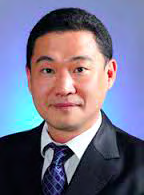Prof. Mingguang He: China has increasingly been recognized as the land for clinical research and innovation
Prof. Mingguang He: China has increasingly been recognized as the land for clinical research and innovation
来源期刊: 眼科学报 |
2016年9月 第31卷 第3期: |
203-204
发布时间:
收稿时间:2024/12/2 22:19:36
阅读量:905
- 作者:
-
- 关键词:
-
-
- DOI:
-
doi: 10.3978/j.issn.1000-4432.2016.08.07
- 收稿时间:
-
2016-07-25
- 修订日期:
-
- 接收日期:
-
2016-07-30
Mingguang He (Figure 1) is Professor of Ophthalmic
Epidemiology at the University of Melbourne and Centre
of Eye Research Australia. He completed medical school
at the Sun Yat-sen University in Guangzhou followed by
research training at Johns Hopkins University (MPH) and
University College London (MSc and PhD). His research
interests include clinical and epidemiological research,
randomized trials, twin studies, and imaging technology.
Dr. He has published more than 100 papers in the peerreviewed
literature and several book chapters. He has given
more than 30 invited lectures at regional and international
conferences. He serves as associate editor for Eye Science
and an editorial board member for PloS One, International
Glaucoma Review, and several Chinese ophthalmic journals.
Dr. He has received several awards including a University
College London Graduate Research Scholarship and
Overseas Research Scholarship, Top 3 and Top 10 best
poster awards from the World Glaucoma Congress in
Vienna and Singapore, best paper presentation at the
SEAGIG conference, and distinguished young scholar
award from the National Natural Science Foundation.
After the Zhongshan Medical Retina and Epidemiology
Symposium, I was honored to have an interview with Dr.
He. Here the interview goes.
Figure 1 Prof. Mingguang He.
YKXB: Dr. He! We learn that the global population
suff ering from blindness is rapidly increasing and you’ve
been working against global blindness for years. Could you
please inform us what are the leading causes of blindness?
And approximately in which percentage of these blind
people are curable and restore their sight again?
Prof. He: In 2014, the World Health Organi zation
estimated that there are 285 million people visually
impaired while 39 million are blind and 246 with low
vision. The leading cause of visual impairment and
blindness in developing countries including China is
cataract. Uncorrected refractive error is also an important
attributable cause for moderate and severe visual
impairment. Roughly 80% of these diseases are avoidable
either curable or potentially preventable.
YKXB: Now, you are an ophthalmologist from both
Zhongshan Ophthalmic Center (ZOC) and University of
Melbourne. Was there any significant joint project, you
hosted, between Chinese and Australian ophthalmologists
in recent 5 years?
Prof He: Yes—in the past 3 years we have been working
with Australian scientists, Ian Morgan and Kathryn Rose
to design and implement a school-based clinical trial on
understanding whether increased amount of outdoor time
would prevent myopia in school-aged children. We are also
working on a project, namely Australia-China Research
Accelerator, with an aim to bring Australian expertise and
scientists to China and help our Chinese partner hospitals
develop their capacity on clinical research, linking them
up to run multi-centre studies and bringing synergism and
impact to the research society in both China and Australia.
YKXB: In what aspect of ophthalmology is there a booming
potential for China-Australia cooperation in the next 5 years?
Prof. He: Australia has a lot of dedicated scientists, very good
facilities and several well-documented research cohorts. They
have well-established facilities and expertise on running high
quality research. If we can develop research cohorts, working
on the studies with similar aims and later on comparing the
results in Chinese and predominately European people in
Australia, it would generate unprecedented data to understand
the diseases and the contribution of genetic and lifestyle factors.
But this would need to make sure the phenotype collection in
both Australia and China are comparable with similar deff nition
and quality.
YKXB: To my acknowledgement, your team are doing SiDRP
program. Could you please kindly introduce this program?
Could you summarize the key points of how to screen the
diabetic retinopathy in communities? What progress has been
achieved in advanced countries, for instance, Australia?
Prof. He: SiDRP is a program hosted by Singapore National
Eye Centre, trying to develop an efficient nation-wide program
for diabetic retinopathy screening. We are running program
similar in both Australia and China, but not exactly the same or
part of the SiDRP. We are working with Lifeline Express Project
on helping them develop DR screening program by providing
cloud-based platform and also helping them develop reading
centers, we are also working on adapting artificial intelligence
based automated diagnosis in both Australia and China.
YKXB: Since 2016, APAO council permanently settles in
ZOC, Guangzhou and you are the Deputy Secretary-General
of APAO council. Could you expect, what positive impact of
this event will bring to the development of ophthalmology in
China in the near future?
Prof. He: APAO is a super-national organization with a mission
to promote the development and to foster collaboration in the
field of ophthalmology in the region. The APAO permanent
premise relocating to ZOC in Guangzhou will become a good
opportunity for ZOC faculties to interact with international
experts, in terms of both clinical and management, which will
improve the international proff le of ZOC.
YKXB: The international collaboration and project between
Chinese Ophthalmic Center and those from other countries
is booming these years. However, there is saying that no
innovation has made in China and Chinese foundation research is so poor that it only off ers the free lobar force for
other contrives. What roles of Chinese institution especially
ZOC are playing or would play you expect in the international
collaboration in conquering the eye diseases with global
institutions?
Prof. He: China has increasingly been recognized as the land
for clinical research and innovation due to its densely populated
patients pool, high volume serve providers and track record of
efff cient patient enrolment. We are never lack of innovation, we
just need to more open to the world, and also develop our own
system and culture that allows young generation to take lead
and responsibility to run the innovative projects and ideas.
YKXB: The last one, we saw many frequently cited ff ndings
from you published on top-tier ophthalmologic journals, such
as IOVS, Ophthalmology, etc. And you are a member of the
Editorial Board of Eye Science and contribute a lot to this
academic journal. In your opinion, what is the urgent task for
Eye Science in order to increase its influence and catch up with
peer journals with high impact factors?
Prof. He: I am serving the editorial board of Ophthalmology,
Clinical Experimental Ophthalmology and Mol Vis. I can see lots
of changes after the appointment of new management team.
The priority/next step, should be restructure the editorial board
by inviting prominent scientists to join the board, developing a
dynamic mechanism allowing EBM contribute manuscript in
particular review articles.
YKXB: Thank you so much for sharing your opinion and
your valuable time.



